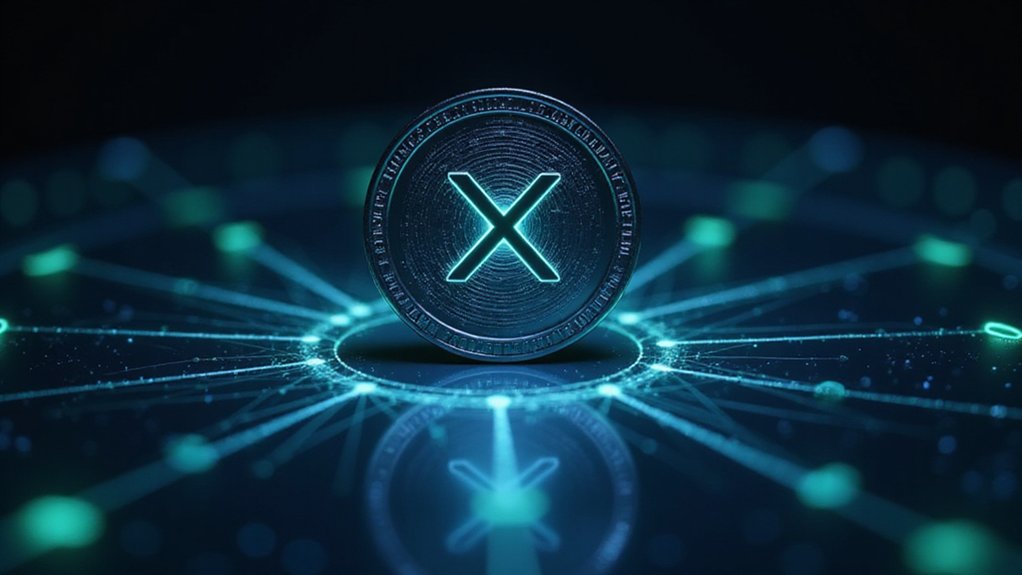XCN is the native token of the Onyx Protocol blockchain network, operating on Ethereum’s infrastructure while delivering near-instant transactions with surprisingly minimal fees. Beyond basic value transfer, XCN empowers holders with governance rights through the Onyx DAO, where they vote on protocol changes. The permanently supply-capped asset incorporates staking mechanisms that reward participants with passive income while simultaneously securing the network—a rather elegant alignment of individual incentives with collective security needs.

The native token of the Onyx Protocol blockchain network, XCN stands as a multifaceted digital asset operating primarily on Ethereum’s infrastructure—where decentralized finance meets institutional-grade functionality.
This permanently supply-capped token serves as the lifeblood of an ecosystem designed to revolutionize financial services through blockchain technology, offering near-instant transaction confirmations and remarkably low fees (a welcome departure from the eye-watering costs that have become all too familiar in the crypto space).
XCN’s utility extends far beyond mere transactional capabilities.
XCN transcends simple transactions, embodying a sophisticated ecosystem where utility meets governance in blockchain’s institutional frontier.
Token holders wield governance authority through the Onyx DAO, effectively transforming users into stakeholders with genuine voting rights on protocol changes and development trajectories. Despite experiencing a notable 24H change at -0.71%, the token maintains strong community participation in governance decisions.
This democratic approach—quaint as it may seem in an industry often dominated by venture capital whims—creates a self-reinforcing loop of community engagement and protocol improvement.
The token’s economic model incorporates staking mechanisms that simultaneously secure the network and reward participants.
By locking their XCN, holders contribute to network validation while generating passive income streams—a rather elegant solution to the age-old problem of aligning individual incentives with collective security needs.
These staked positions further cement the relationship between token utility and network health.
From a technical perspective, Onyx Protocol employs a modular blockchain architecture optimized for financial applications, with XCN serving multiple functions: payment method for infrastructure services, requirement for node deployment, and gateway to premium ecosystem services.
The design prioritizes interoperability—acknowledging that no blockchain is an island (despite what maximalists might insist).
Listed on major exchanges including Kraken and Coinbase, XCN benefits from substantial liquidity channels. Investors appreciate Kraken’s robust security measures when trading XCN alongside other cryptocurrencies. The current market cap of £443,210,140.87 reflects its significant position among crypto assets, ranking #93 in popularity.
Its fixed supply model theoretically insulates holders from inflationary pressures, while its dual utility and governance functions create natural demand dynamics within the ecosystem.
As financial institutions increasingly explore blockchain integration, tokens like XCN—combining institutional-grade performance with decentralized governance—occupy a potentially consequential position in the evolving digital asset landscape.
Frequently Asked Questions
What Are the Risks Associated With Investing in XCN Crypto?
XCN investment carries substantial risks: extreme price volatility (42% drops in short periods), dwindling liquidity evidenced by record-low active addresses, and potential sell-pressure from profit-taking holders.
Smart contract vulnerabilities, regulatory uncertainties, and potential market manipulation (courtesy of whale dominance) further compromise its outlook.
Its nascent operational history exacerbates assessment difficulties, while its competitive positioning against established blockchain ecosystems—coupled with an AI integration dependency that may never materialize—presents formidable adoption challenges.
How Does XCN Compare to Other Blockchain Governance Tokens?
XCN distinguishes itself from typical governance tokens through its dual utility-governance structure—offering both voting rights and practical functionality within the Onyx ecosystem.
While many governance tokens serve solely as voting mechanisms, XCN provides tangible benefits like fee discounts and payment options.
Its relatively high maximum supply (48.47 billion) contrasts with scarcity-focused alternatives, and its technological implementation across Ethereum and Arbitrum layers enables more efficient participation than single-chain governance competitors.
Can XCN Be Staked for Passive Income?
XCN can indeed be staked for passive income, with several platforms offering this functionality—notably MyCointainer and CoinUnited.io, the latter boasting a rather ambitious 55% APY.
Rewards distribute hourly, enabling frequent compounding (a feature crypto enthusiasts inexplicably celebrate).
Beyond mere financial returns, stakers receive governance rights, influencing network decisions while contributing to protocol security.
As with all proof-of-stake arrangements, rewards fluctuate with market conditions and network activity—a reality often glossed over in promotional materials.
What Exchanges Currently List XCN Tokens?
XCN tokens currently enjoy listing across a spectrum of prominent exchanges.
The cryptocurrency maintains presence on major platforms including Kraken, Coinbase, Binance, KuCoin, and Gate.io—each offering various trading pairs and market data.
Additionally, decentralized exchanges like Uniswap and Sushiswap likely support XCN given its ERC-20 compatibility.
The token’s native platform, Onyx Protocol, naturally accommodates trading and staking functions, while regional exchanges in Asian and European markets may provide supplementary access points for traders seeking governance exposure.
What Is the Long-Term Roadmap for XCN Development?
XCN’s development roadmap unfolds in three distinct phases, with Phase One (core infrastructure) already completed in Q4 2023.
Phase Two is currently underway, focusing on enhancing scalability and transaction throughput.
The most ambitious stretch—Phase Three—targets 2025 completion, emphasizing cross-chain compatibility and developer tools for dApps.
Starting April 2024, a measured token release of 200 million XCN monthly commences, reflecting a deliberately patient approach to ecosystem expansion in the volatile crypto landscape.









